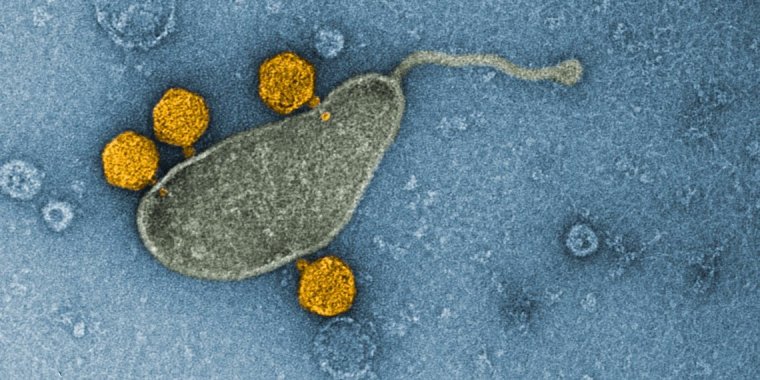| News / Science News |
The most common organism in the oceans harbors a virus in its DNA
The most common organism in the oceans, and possibly on the entire planet, is a family of single-celled marine bacteria called SAR11. These drifting organisms look like tiny jelly beans and have evolved to outcompete other bacteria for scarce resources in the oceans.

The viruses, colored orange, are attached to the SAR11 marine bacteria, colored gray. Photo: Morris et al./Nature Microbiology
We now know that this group of organisms thrives despite -- or perhaps because of – an ability to host viruses in its DNA. The viruses are harmless to humans.
University of Washington oceanographers discovered that the virus hosted by SAR11 (Pelagibacter) bacteria is unique.
The virus is of a type that spends most of its time dormant in the host's DNA but occasionally erupts to infect other cells, potentially carrying some of its host's genetic material along with it.
"Many bacteria have viruses that exist in their genomes, but people had not found them in the ocean's most abundant organisms," said co-lead author Robert Morris. "We suspect it's probably common, or more common than we thought -- we just had never seen it."
This virus' two-pronged survival strategy differs from similar strategies found in other organisms. The virus lurks in the host's DNA and gets copied as cells divide, but for reasons still poorly understood, it also replicates and is released from other cells.
The study shows that as many as 3% of the SAR11 cells can multiply and split, or lyse, the cell -- a much higher percentage than for most viruses that inhabit a host's genome. That produces a large number of free viruses and could be key to their survival.
"There are 10 times more viruses in the ocean than there are bacteria," Morris said. "Understanding how these large numbers are maintained is important. How does a virus survive? If you kill your host, how do you find another host before you degrade?"
The study could prompt basic research that could help clarify host–virus interactions in other settings.
"If you study a system in bacteria, then you can sort out the basic mechanisms," Morris said. "The results could eventually help in biomedical applications." (National Science Foundation)
YOU MAY ALSO LIKE





